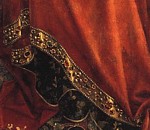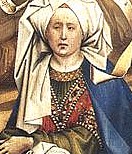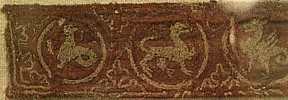
Medieval
Clothing Embellishments
JEWELLED BANDS & HEMS - EMBROIDERY ON CLOTHES
SPANGLES - PRESSED METAL SPANGLES or GAUFFRES
 The
finishing touches to a woman's garment defined who she was or
in many cases, who she aspired to be. The
finishing touches to a woman's garment defined who she was or
in many cases, who she aspired to be.
Sumptuary Laws fought alongside the clergy urging women to dress
moderately and not above their station in life, but this was largely
ignored by the rising merchant classes who were eager to mirror
the fashions seen at court and worn by their social superiors.
The upper classes, therefore, trimmed their clothing even more
richly to combat this trend.

 Jewelled
bands and hems Jewelled
bands and hems
Many artworks from the medieval period show heavily decorated
bands along the edges of cloaks and along the bottom of overgarments.
The detail at top right comes from the 1410 painting from Campin
of Saint Veronica and shows the typical jewelled band at
the hem of her outer gown. Her brocaded undergown or kirtle can
be seen underneath.
Many surcotes, like that
shown in Campin's The Nativity, at left, painted in 1420,
show a similar band at the sleeves and on the deep V of the neckline.
Both of these appear to have a gold, metallic band with many small
gemstones attached.
The Nativity painting appears to show what could possibly
be pearls edging the band also. A garment such as these would
be worth quite a sum and certainly set a wealthy woman apart from
the less well-off woman who might have a garment cut the same
but without the trim.

 Embroidery
on medieval clothing Embroidery
on medieval clothing
Embroidery was
an acceptable pastime of the noble lady and indeed it was considered
one of her finer accomplishments. Many of the embroidery techniques
used in the middle ages are still in use today- couching, split
stitch and appliqué.
Embroidery was used to provide
finishing touches to almost any garment, dependign on the time
period and the fashion.
Veils might also be embroidered at the edges.
Popular art shows many surcotes with embroidered bands. Popular
motifs included heraldry, mottos or phrases of love, animals,
flowers and botanical themes and religious scenes and characters
like the Virgin and Son or a patron saint.
The detail above from the
1445-1450 painting by Rogier van der Weyden of Saints Margaret
And Apollonia shows embroidery, possibly gold thread, around
the neckline of the garment. Another detail at right from the
same painting also shows the bottom edge of a mantle with its
heavy gold embroidery. The kirtle underneath and brocaded surcote
can clearly be seen also.
 There
are very few existent fragments of medieval embroidery remaining.
A beautiful sample of can be seen below at left, on an embroidered
band. There
are very few existent fragments of medieval embroidery remaining.
A beautiful sample of can be seen below at left, on an embroidered
band.
The embroidery was sewn onto a separate strip of fabric which
was then stitched to the garment.
Dated at the 13th century, it is a band of fantastic animals in
roundels embroidered with gold thread on silk twill. Photo ©Timothy
Mitchell, Victoria Albert Museum of London.

Spangles
Looking almost identical to our sequins of today, the spangles
which used to decorate medieval clothing among the upper classes
are effectively exactly that. Small metal discs with a hole punched
in the middle were stitched onto clothing with only a stitch or
two to permit the spangle to move freely.
Again, something afforded to the upper classes and not to others.

Pressed
metal spangles, bezants or gauffres
 Another
decorative clothing embellishment is the pressed metal decoration.
Patterns were pressed or embossed onto inexpensive, thin metal
plates and die cut. The decorations were then sewn onto clothing
or belts. Another
decorative clothing embellishment is the pressed metal decoration.
Patterns were pressed or embossed onto inexpensive, thin metal
plates and die cut. The decorations were then sewn onto clothing
or belts.
The image at left shows small
metal decorations sewn onto an altar cloth. Althought this is
not an item clothing, it is indicitive of the type of spangle
produced at the time.

Copyright
© Rosalie Gilbert
All text & photographs within this site are the property of
Rosalie Gilbert unless stated.
Art & artifact images remain the property of the owner.
Images and text may not be copied and used without permission.
|